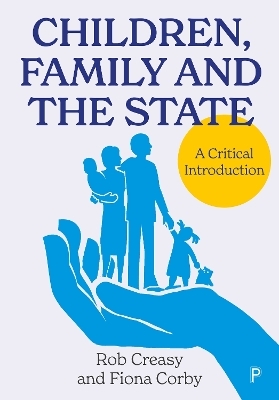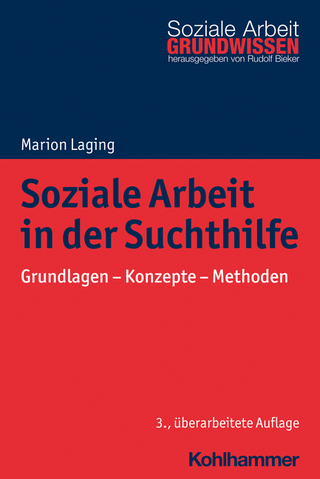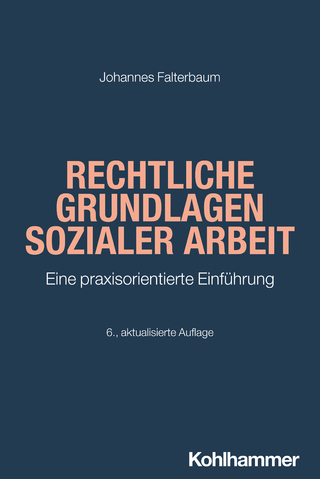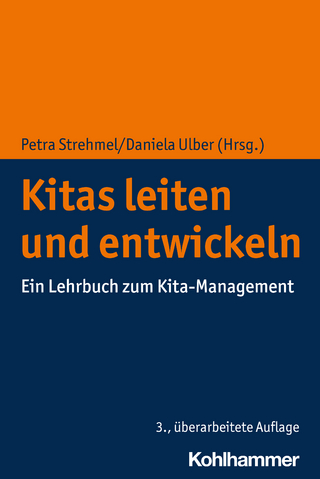
Children, Family and the State
Policy Press (Verlag)
978-1-4473-6894-6 (ISBN)
For anyone studying childhood or families, a consideration of the state may not always seem obvious, yet a good critical knowledge of politics, social policy and social theory is vital to understanding their impacts upon families’ everyday lives. Accessibly written and assuming no prior understanding, it shows how key concepts, including vulnerability, risk, resilience, safeguarding and wellbeing are socially constructed.
Carefully designed to support learning, it provides students with clear guidance on how to use what they have read when writing academic assignments alongside questions designed to support the development of critical thinking skills.
Covering issues from what the family is within a multicultural society, through issues around poverty, social mobility and life-chances, this book gives students an excellent grounding in matters relating to work with children and families. It features:
• ‘using this chapter’ sections showing how the content can be used in assignments;
• tips on applying critical thinking to books and articles – and how to make use of such thinking in essays;
• further reading.
Rob Creasy is an independent researcher. He is a Senior Fellow of the Higher Education Authority and was previously subject director for social science at York St John University. Fiona Corby is Senior Lecturer in Education at Teesside University. She has extensive experience of working in children, youth and family services.
1. Introduction
1.1 Why Read This Book
1.2 Bronfenbrenner's Socio-Ecological Model
1.3 Piaget and Vygotsky
1.4 How Does Society Influence Children’s Development?
2. The Family
2.1 What Is a Family?
2.2 Seeing the Things We Do for Love as a Script To Be Followed
2.3. How Have Relationships Changed?
2.4. Does Reflexivity Mean That We Project Manage Our Own Lives?
2.5. How Discourse Makes Us Believe the Way Families Behave Is Natural
2.6 How Does Discourse Have Power?
2.7 How State Governance Draws Upon Discourse
2.8 How Might You Use This Chapter
3. Parenting and Failing Families
3.1 How Does the State Regulate Families
3.2 Is It the Case That What Parents Do Is More Important Than Who Parents Are?
3.3 Does Social Class Influence Parenting?
3.4 Should the State Help Parents?
3.5 What Do We Mean by Failing or Troubled Families
3.6 Can Failing Families Be Seen as Part of an Underclass?
3.7 Murray and the Start of Concerns
3.8 Being Critical and Using This Chapter
4. The State
4.1 Why Is the State Relevant to Studying Children and Families?
4.2 Can the State Do Things That Individuals Cannot?
4.3 How Values Shape What the State Does
4.4 What Do We Mean by the State
4.5 How the State Can Regulate the Context of Your Life
4.6 Should We Give Up Personal Freedoms and Let the State Have More Power?
4.7 Considering the Power of the State
4.8 Rights, and Some Arguments for Restricting or Removing Them
4.9 Removing Rights Because of Who, or What, You Are
4.10 Democracy and Populism
4.11 Making Use of This Chapter in an Assignment
5. The Relevance of Political Ideologies
5.1 What Do We Mean by Political Ideologies
5.2 Making Sense of Left and Right in Politics
5.3 Neoliberalism: Individuals, Free Markets and Inequality
5.4 Neoconservatism: Morals, Culture Wars and Nationalism
5.5 Social Democracy: Equal Opportunities, Social Inclusion and the Third Way
5.6 Communitarianism
5.7 Social and Cultural Capital
5.8 What You Can Do With This Chapter To Make Your Assignments Stronger
6. Welfare, Policy and the Family
6.1 How Is Ideology Put Into Practice
6.2 How Does Ideology Underpin Welfare?
6.3 How Have Ideas About the Family Shaped Welfare Services?
6.4 Deserving, Undeserving and the Problem of Need
6.5 How Can We Ensure That Welfare Only Goes to the Deserving?
6.6 How the State Shapes Family Life
6.7 So What?
7. Wellbeing
7.1 What Do We Mean by Wellbeing
7.2 Does Wellbeing Represent Individualisation?
7.3 Inequality and Wellbeing
7.4 The Key Ideas That Really Should Be in an Essay
8. Vulnerable Children
8.1 A Discourse of Children As Naturally Vulnerable
8.2 Policy and Need
8.3 What Is the Social Context of Vulnerability?
8.4 What Might You Use in an Essay Out of This Chapter?
9. Resilience
9.1 Why Is Resilience Important?
9.2 What Do We Mean by Resilience
9.3 Can Parents Help To Develop Resilience
9.4 Why We Need Adversity
9.5 What Can I Do With This?
10. Risk
10.1 Children, Risk and Resilience
10.2 The Move Towards Individual Responsibility, Reflexivity and Choice
10.3 Are We Protecting Children When We Remove All Risks?
10.4 Where Do I Fit This In
11. Safeguarding
11.1 How Culture and Values Define a Child in Need and a Child Being Harmed
11.2 Should We Keep All Children and Young People Safe?
11.3 Sex, Technology and Risk
11.4 The Social and Political Context
11.5 Making Use of This in Assignments
12. Life-Chances, Inequalities and Social Mobility
12.1 How Life-Chances Explain Social Inequalities
12.2 How Life-Choices Explain Social Inequalities
12.3 What Social Inequalities and What Is Wrong With Inequality?
12.4 What Can the State Do About Inequalities?
12.5 Why Is In-Work Poverty Important
12.6 Why Housing Matters to Children
12.7 Is Social Mobility Important for Children?
12.8 Using This Chapter
13. What, There’s No Conclusion?
13.1 So What?
| Erscheinungsdatum | 28.03.2023 |
|---|---|
| Zusatzinfo | 1 Tables, black and white |
| Sprache | englisch |
| Maße | 170 x 244 mm |
| Themenwelt | Sozialwissenschaften ► Pädagogik ► Sozialpädagogik |
| Sozialwissenschaften ► Politik / Verwaltung ► Politische Systeme | |
| Sozialwissenschaften ► Politik / Verwaltung ► Politische Theorie | |
| Sozialwissenschaften ► Soziologie | |
| ISBN-10 | 1-4473-6894-0 / 1447368940 |
| ISBN-13 | 978-1-4473-6894-6 / 9781447368946 |
| Zustand | Neuware |
| Informationen gemäß Produktsicherheitsverordnung (GPSR) | |
| Haben Sie eine Frage zum Produkt? |
aus dem Bereich


